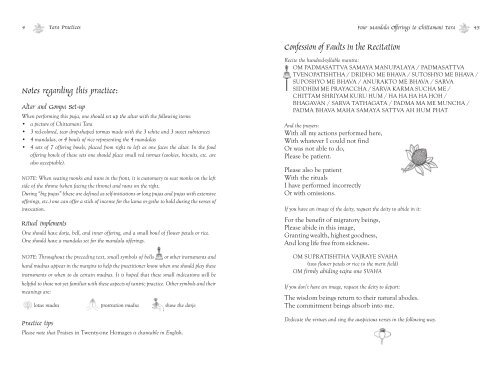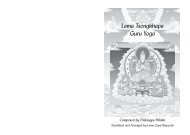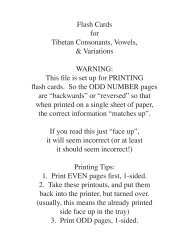4_Mandala_Tara_ Puja.. - Kurukulla Center for Tibetan Buddhist ...
4_Mandala_Tara_ Puja.. - Kurukulla Center for Tibetan Buddhist ...
4_Mandala_Tara_ Puja.. - Kurukulla Center for Tibetan Buddhist ...
You also want an ePaper? Increase the reach of your titles
YUMPU automatically turns print PDFs into web optimized ePapers that Google loves.
4 <strong>Tara</strong> Practices<br />
Notes regarding this practice:<br />
Altar and Gompa Set-up<br />
When per<strong>for</strong>ming this puja, one should set up the altar with the following items:<br />
• a picture of Chittamani <strong>Tara</strong><br />
• 3 red-colored, tear drop-shaped tormas made with the 3 white and 3 sweet substances<br />
• 4 mandalas, or 4 bowls of rice representing the 4 mandalas<br />
• 4 sets of 7 offering bowls, placed from right to left as one faces the altar. In the food<br />
offering bowls of these sets one should place small red tormas (cookies, biscuits, etc. are<br />
also acceptable).<br />
NOTE: When seating monks and nuns in the front, it is customary to seat monks on the left<br />
side of the throne (when facing the throne) and nuns on the right.<br />
During “big pujas” (these are defined as self-initiations or long pujas and pujas with extensive<br />
offerings, etc.) one can offer a stick of incense <strong>for</strong> the lama or geshe to hold during the verses of<br />
invocation.<br />
Ritual implements<br />
One should have dorje, bell, and inner offering, and a small bowl of flower petals or rice.<br />
One should have a mandala set <strong>for</strong> the mandala offerings.<br />
NOTE: Throughout the preceding text, small symbols of bells or other instruments and<br />
hand mudras appear in the margins to help the practitioner know when one should play these<br />
instruments or when to do certain mudras. It is hoped that these small indications will be<br />
helpful to those not yet familiar with these aspects of tantric practice. Other symbols and their<br />
meanings are:<br />
lotus mudra prostration mudra show the dorje<br />
Practice tips<br />
Please note that Praises in Twenty-one Homages is chantable in English.<br />
Confession of Faults in the Recitation<br />
Four <strong>Mandala</strong> Offerings to Chittamani <strong>Tara</strong> 45<br />
Recite the hundred-syllable mantra:<br />
OM PADMASATTVA SAMAYA MANUPALAYA / PADMASATTVA<br />
TVENOPATISHTHA / DRIDHO ME BHAVA / SUTOSHYO ME BHAVA /<br />
SUPOSHYO ME BHAVA / ANURAKTO ME BHAVA / SARVA<br />
SIDDHIM ME PRAYACCHA / SARVA KARMA SUCHA ME /<br />
CHITTAM SHRIYAM KURU HUM / HA HA HA HA HOH /<br />
BHAGAVAN / SARVA TATHAGATA / PADMA MA ME MUNCHA /<br />
PADMA BHAVA MAHA SAMAYA SATTVA AH HUM PHAT<br />
And the prayers:<br />
With all my actions per<strong>for</strong>med here,<br />
With whatever I could not find<br />
Or was not able to do,<br />
Please be patient.<br />
Please also be patient<br />
With the rituals<br />
I have per<strong>for</strong>med incorrectly<br />
Or with omissions.<br />
If you have an image of the deity, request the deity to abide in it:<br />
For the benefit of migratory beings,<br />
Please abide in this image,<br />
Granting wealth, highest goodness,<br />
And long life free from sickness.<br />
OM SUPRATISHTHA VAJRAYE SVAHA<br />
(toss flower petals or rice to the merit field)<br />
OM firmly abiding vajra one SVAHA<br />
If you don’t have an image, request the deity to depart:<br />
The wisdom beings return to their natural abodes.<br />
The commitment beings absorb into me.<br />
Dedicate the virtues and sing the auspicious verses in the following way.





